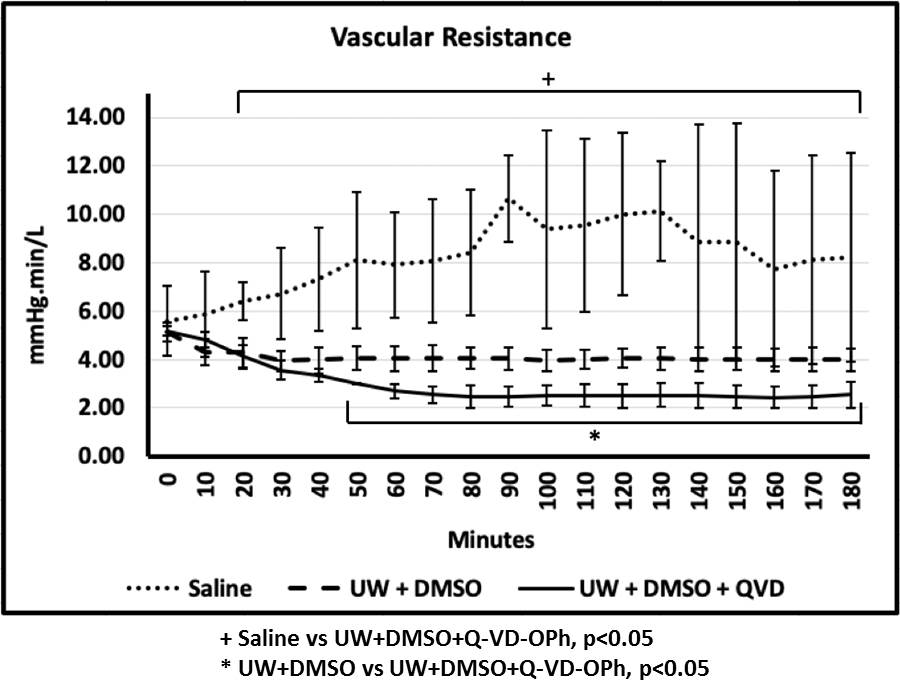Protection of the Donor Kidney Vascular Endothelium by Ex-Vivo Perfusion with a Pan-Caspase Inhibitor
1Transplant Microsurgery Program, University of Colorado, Aurora, CO, 2Renal Division, University of Colorado, Aurora, CO
Meeting: 2019 American Transplant Congress
Abstract number: A77
Keywords: Endothelial cells, Preservation
Session Information
Session Name: Poster Session A: Endothelial Cell Biology
Session Type: Poster Session
Date: Saturday, June 1, 2019
Session Time: 5:30pm-7:30pm
 Presentation Time: 5:30pm-7:30pm
Presentation Time: 5:30pm-7:30pm
Location: Hall C & D
*Purpose: Orthotopic kidney transplantation is a life-saving therapeutic option for patients with end stage organ failure. Pulsatile perfusion (PP) of deceased donor kidneys is increasingly used and reduces the rate of delayed graft function (DGF) compared to static preservation. High vascular resistance during PP may lead to DGF, primary non-function (PNF) and kidney discard. We hypothesized that prevention of endothelial injury using a pan-caspase inhibitor, Q-VD-OPh, may prevent increased vascular resistance during PP.
*Methods: Donor kidneys from C57Bl/6J mice were subjected to perfusion with either: 1) isotonic saline, 2) UW solution + DMSO (vehicle for Q-VD-OPh) or 3) UW solution + DMSO and the pan-caspase inhibitor, Q-VD-OPh. Kidneys were perfused at 4oC for 3hrs at a constant flow rate and vascular resistance was monitored. At the end of 3hrs, perfused kidneys were stained for von Willebrand Factor (vWF) expression as a marker of endothelial injury. The contralateral kidney was used as a control. Scoring was performed in a blinded fashion. Data were analyzed by ANOVA and significance was defined as p<0.05.
*Results: Vascular resistance was significantly increased by saline over the entire perfusion period, and was characterized by a wide range of values indicating significant vascular reactivity. UW solution + DMSO + Q-VD-OPh resulted in the lowest vascular resistance with minimal variation indicating vasomotor stability (Figure 1).
Staining for vWF revealed significantly increased expression in saline treated kidneys whereas UW + DMSO and UW + DMSO + Q-VD-OPh resulted in vWF expression comparable to controls (Figure 2).
*Conclusions: Increased vascular resistance during PP may lead to donor kidney discard, DGF and PNF. We have demonstrated that perfusion of donor kidneys with the pan-caspase inhibitor, Q-VD-OPh, is associated with vasomotor stability, significantly decreased vascular resistance and decreased vWF staining suggesting endothelial cell protection. Strategies to prevent vasomotor instability and increased vascular resistance may reduce donor discard, improve graft outcomes and deserve further study.
To cite this abstract in AMA style:
Plenter R, Jain S, Nydam T, jani A. Protection of the Donor Kidney Vascular Endothelium by Ex-Vivo Perfusion with a Pan-Caspase Inhibitor [abstract]. Am J Transplant. 2019; 19 (suppl 3). https://atcmeetingabstracts.com/abstract/protection-of-the-donor-kidney-vascular-endothelium-by-ex-vivo-perfusion-with-a-pan-caspase-inhibitor/. Accessed January 6, 2026.« Back to 2019 American Transplant Congress


